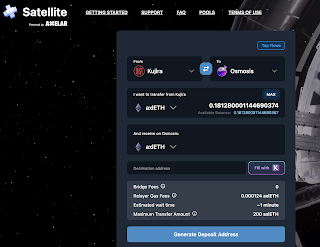Wednesday, May 31, 2023
2023-05-31 ETHBTC experiment, Day 3
Closing a short on Kujira
- I draw-down some of the collateral from Ghost
- With that, I buy $LUNA. Cheapest now is on Terra @astroport_fi, so I bridge the funds to Terra, buy the $LUNA, and bridge the $LUNA back to @TeamKujira
- With that $LUNA, I pay-off the borrow.
Tuesday, May 30, 2023
ETHBTC experiment, Day 2, 2023-05-30
swap 0.1823 ETH
Anybody want to borrow $wBTC? As the price is falling, you can short it, so that when you pay back the borrow, you pay less than what you borrowed it.
Top 15 FIN order books by volume, 2023-05-30
Top 15 FIN order books by volume, 2023-05-30
- KUJI/axlUSDC,$77.93K
- axlUSDC/USK,$21.51K
- KUJI/USK,$13.45K
- ATOM/axlUSDC,$9.85K
- ATOM/USK,$8.88K
- MNTA/USK,$3.61K
- JUNO/axlUSDC,$2.61K
- INJ/USK,$2.28K
- MARS/axlUSDC,$2.07K
- LUNA/USK,$1.62K
- MNTA/axlUSDC,$1.57K
- KUJI/ATOM,$1.43K
- LUNA/axlUSDC,$1.07K
- OSMO/axlUSDC,$1.04K
- WHALE/USK,$1.03K
Report generated by ./top_order_books
Top 5 LPs on @TeamKujira BOW, 2023-05-30
Top 5 LPs on @TeamKujira BOW by volume, 2023-05-30
- axlUSDC/USK,$1068943.875,7%,25%
- axlUSDC/USK,$1068943.875,7%,25%
- KUJI/USK,$673539.062,1%,29%
- KUJI/USK,$673539.062,1%,29%
- ampKUJI/KUJI,$512336.062,0%,1%
Showing all LPs with $100k+ volume
Top 5 LPs on @TeamKujira BOW by APR(combined), 2023-05-30
- PEPE/wETH,$0.000,508%,508%
- PEPE/wETH,$0.000,508%,508%
- ROAR/USK,$14802.610,5%,153%
- ROAR/USK,$14802.610,5%,153%
- MNTA/USK,$51662.609,17%,153%
Showing all LPs with 100%+ APR/APY
Top 5 LPs on @TeamKujira BOW by APR(21 Day Trading), 2023-05-30
- PEPE/wETH,$0.000,508%,508%
- PEPE/wETH,$0.000,508%,508%
- WHALE/USK,$27861.529,39%,110%
- WHALE/USK,$27861.529,39%,110%
- MNTA/USK,$51662.609,17%,153%
Report generated by ./lps
Monday, May 29, 2023
ETHBTC EMA-20 Spreadsheet
NEW SPREADSHEETSZORXEN!
This spreadsheet uses the EMA-20 to make BTC/ETH swap determinations.
It's available for you to copy and to use as a #cryptocurrency resource on my Crypto-page.
Day 1
Top 15 FIN order books by volume, 2023-05-29
Top 15 FIN order books by volume, 2023-05-29
- KUJI/axlUSDC,$71.19K
- axlUSDC/USK,$43.66K
- KUJI/USK,$19.19K
- ATOM/USK,$18.95K
- ATOM/axlUSDC,$10.05K
- wETH/axlUSDC,$5.80K
- LUNA/axlUSDC,$3.85K
- MNTA/axlUSDC,$2.71K
- WHALE/USK,$2.57K
- wBNB/USK,$2.21K
- KUJI/ATOM,$2.14K
- wBNB/axlUSDC,$2.00K
- MNTA/USK,$1.72K
- LUNA/USK,$1.60K
- INJ/USK,$1.05K
Report generated by ./top_order_books
Top 5 LPs on @TeamKujira BOW, 2023-05-29
Top 5 LPs on @TeamKujira BOW by volume, 2023-05-29
- axlUSDC/USK,$1045557.625,7%,26%
- KUJI/USK,$672929.625,1%,29%
- ampKUJI/KUJI,$457890.781,0%,0%
- KUJI/ATOM,$235111.094,16%,20%
- KUJI/axlUSDC,$164643.516,6%,12%
Showing all LPs with $100k+ volume
Top 5 LPs on @TeamKujira BOW by APR(combined), 2023-05-29
- PEPE/wETH,$0.000,508%,508%
- MNTA/axlUSDC,$42564.629,0%,162%
- MNTA/USK,$49280.301,17%,157%
- ROAR/USK,$14394.530,5%,157%
- MARS/axlUSDC,$20522.199,0%,133%
Showing all LPs with 100%+ APR/APY
Top 5 LPs on @TeamKujira BOW by APR(21 Day Trading), 2023-05-29
- PEPE/wETH,$0.000,508%,508%
- WHALE/USK,$28122.980,40%,114%
- MNTA/USK,$49280.301,17%,157%
- KUJI/ATOM,$235111.094,16%,20%
- FURY/USK,$732.330,13%,50%
Report generated by ./lps
Cryptocurrency pop-quiz: ETHBTC with proportional swaps
Sunday, May 28, 2023
Top 13 FIN order books by volume, 2023-05-28
Top 13 FIN order books by volume, 2023-05-28
- KUJI/axlUSDC,$136.99K
- KUJI/USK,$88.22K
- axlUSDC/USK,$74.35K
- ATOM/axlUSDC,$33.83K
- ATOM/USK,$8.39K
- LUNA/USK,$4.15K
- KUJI/LOCAL,$4.14K
- LUNA/axlUSDC,$3.08K
- WHALE/USK,$3.02K
- KUJI/ATOM,$2.55K
- KUJI/LUNA,$2.51K
- MNTA/USK,$1.70K
- PAXG/axlUSDC,$1.04K
Report generated by ./top_order_books
Top 5 LPs on TeamKujira BOW, 2023-05-28
Top 5 LPs on @TeamKujira BOW by volume, 2023-05-28
- axlUSDC/USK,$1007831.812,7%,25%
- KUJI/USK,$650932.750,1%,29%
- ampKUJI/KUJI,$430427.688,0%,0%
- KUJI/ATOM,$229260.562,17%,20%
- KUJI/axlUSDC,$161687.422,6%,12%
Showing all LPs with $100k+ volume
Top 5 LPs on @TeamKujira BOW by APR(combined), 2023-05-28
- PEPE/wETH,$0.000,401%,401%
- MNTA/axlUSDC,$36589.391,0%,186%
- MNTA/USK,$47603.320,18%,161%
- ROAR/USK,$13580.720,5%,158%
- MARS/USK,$16308.090,0%,126%
Showing all LPs with 100%+ APR/APY
Top 5 LPs on @TeamKujira BOW by APR(21 Day Trading), 2023-05-28
- PEPE/wETH,$0.000,401%,401%
- WHALE/USK,$28211.920,40%,116%
- MNTA/USK,$47603.320,18%,161%
- KUJI/ATOM,$229260.562,17%,20%
- FURY/USK,$739.920,12%,44%
Report generated by ./lps
Saturday, May 27, 2023
HOWTO arb KUJI ... without arb'n KUJI
Preamble
KUJI -> x -> KUJI arb
- SELL 100 $KUJI at 0.898-per (yields 89.73 $axlUSDC)
- SELL 89.73 $axlUSDC at 0.9651-per (yields 86.536 $USK)
- BUY 100.2 $KUJI from 86.536 $USK
Credit to @technologypoet for giving me this idea by simply asking the question: "Do you place orders one after the other, or all at once?"I had always, up to the point, placed one order after the other, but her question made me ask: "why? Why not place them all at once?"
Other KUJI -> x -> KUJI arbs
KUJI -> ampKUJI -> KUJI arb
- BORROW 100 $KUJI from 300 $axlUSDC on Ghost
- Next, with the 100 (borrowed) $KUJI, place a buy order on the ampKUJI/KUJI FIN order book. Looking at the market, I place my buy at 0.9556 (just above a large buy order, front-running the bigger fish in this pond).
- When that order fills, I claim the $ampKUJI, examine the market, the place a SELL order of the $ampKUJI, completing the arb.
In this case the arb will be around 1%. I'll then pay-back the borrow and then walk away with my 0.9 $KUJI, given to me with OTHER PEOPLE's MONEY.
無 $KUJI arb
- Borrow 100 $USK against 400 $KUJI
- arb the $USK on axlUSDC/USK board
- payback the borrow
- with the overage, buy $KUJI
Crypto pop-quiz answer: ETH/BTC investment apportionment
- One answer: $BTC? $ETH? I don't invest in blue chips!
- Another answer: Can't I make more faster with [name your alt-coin].
- A third: Crypto? Are you insane???
- ETH-BTC: 50%/50%.
- 0.12 $BTC and 1.74 $ETH
Simple Average
- ratio: 0.06837
- simple average: 0.067405
- 1.703 $ETH
- 0.121 $BTC



















































